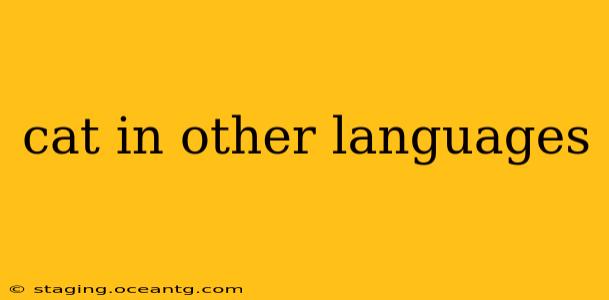Cats. Those enigmatic, furry creatures have captured the hearts and imaginations of people across the globe for millennia. Their presence in our lives transcends language, but the words we use to describe them certainly don't! This comprehensive guide explores how different cultures name these beloved felines, delving into the etymology and nuances of their names in various languages. Let's embark on a multilingual meow-venture!
What are some common names for cats in different languages?
This is a frequently asked question, and rightfully so! The beauty of exploring different languages lies in discovering the subtle variations in how we describe the same animal. While many languages have words directly translating to "cat," the origins and sounds can be surprisingly diverse.
Here's a starting point, featuring some of the most common translations:
- Spanish: Gato (masculine), Gata (feminine) - Simple, elegant, and widely understood.
- French: Chat - A short, charming word with a similar feel to the English "cat."
- German: Katze - A slightly more robust sound than the English word.
- Italian: Gatto (masculine), Gatta (feminine) - Shares a root with the Spanish word, highlighting the interconnectedness of Romance languages.
- Portuguese: Gato (masculine), Gata (feminine) - Again, similar to Spanish, showing linguistic kinship.
- Russian: Кот (kot) - Masculine, and Кошка (koshka) - Feminine. The sounds reflect the Slavic language family's unique phonetic characteristics.
- Japanese: 猫 (neko) - The written characters themselves hint at the animal's agility and grace.
- Chinese (Mandarin): 猫 (māo) - A simple, one-syllable word with a soft sound.
- Korean: 고양이 (goyangi) - A more melodic word compared to many Western languages.
This list is far from exhaustive, of course! There are countless other languages with their own unique words for cats, each carrying its own cultural and historical significance. Many languages also have regional variations or informal terms for cats, adding another layer of complexity and interest to this linguistic exploration.
How did the word "cat" originate?
The English word "cat" has its roots in Proto-Germanic kattuz, ultimately stemming from Proto-Indo-European *kat-. The exact origins are debated among linguists, but it's widely accepted that the word is quite old, reflecting the long and intertwined history of humans and felines. This ancient lineage is mirrored in the etymology of similar words in other Germanic and Romance languages.
Are there different words for cats based on their breed or color?
While not always the case, some languages might utilize descriptive adjectives to further specify a cat's breed or color. For instance, you might hear a specific breed name coupled with the general word for cat, such as "Persian cat" (in various languages). Color distinctions are often handled through adjectives rather than entirely different words. For example, you'd describe a black cat as "gato negro" (Spanish) or "schwarze Katze" (German), employing the standard word for cat but adding a descriptive adjective.
What are some slang terms or nicknames for cats in different languages?
Informal language provides a fascinating insight into the cultural attitudes toward cats. While comprehensive slang dictionaries for various languages on this topic are scarce, exploring different cultures would reveal countless colloquialisms and affectionate nicknames. Further research into individual languages would uncover the rich variety of terms used.
Why do different languages have different words for cats?
The diversity in the words for "cat" across languages largely reflects the independent evolution of those languages. Words for common animals often emerge organically within language families, and changes over time lead to the diverse terms we see today. Geographical separation, cultural influences, and phonetic shifts all contribute to this linguistic diversity. Ultimately, each word carries a unique history and reflects the distinct path each language has taken throughout history.
This exploration of "cat" in other languages provides a glimpse into the rich tapestry of human communication and our enduring relationship with these fascinating creatures. The differences in language only serve to enhance our appreciation for the universality of our love for cats.
